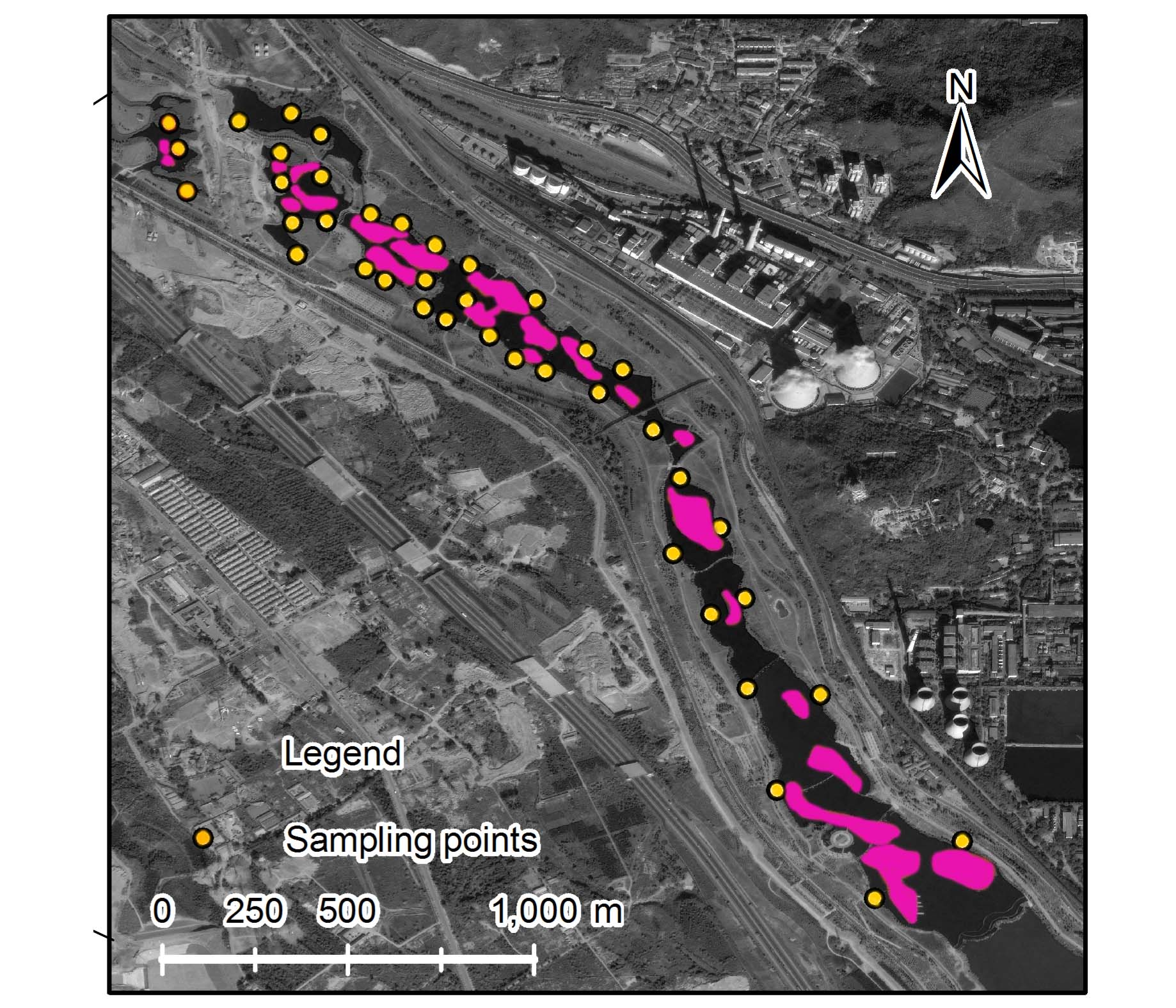

Chlorophyll Fluorescence Response Characteristics of Typical Emergent Plants Under Different Total Nitrogen Gradient
# Co-first authors
Received date: 2015-06-01
Accepted date: 2016-04-26
Online published: 2016-09-27
Measurements and analysis of chlorophyll fluorescence can reflect changes in plant leaf photochemical efficiency and have been increasingly used in plant ecological monitoring. This study used the Mencheng Lake wetland park, supplied with reclaimed water, as a study area, and Phragmites australis, Typha angustifolia and Zizania latifolia as typical emergent plants. We studied the chlorophyll fluorescence response characteristics of plants under different total nitrogen gradient by measuring leaf-scale chlorophyll fluorescence parameters outdoors and the corresponding water total nitrogen content indoors. Minimal fluorescence (Fo) and maximal fluorescence (Fm) were increased and nitrogen content in water was elevated. Maximum quantum efficiency of photochemistry in photosystem II in the dark (Fv/Fm) and quantum efficiency of PSll (ΦPSll) affected by nitrogen increased at first and then plateaued when nitrogen content reached the 15 to 20 mg·L-1 interval. Photochemical quenching (qP) tended to decrease after the first increase, but nonphotochemical quenching (NPQ) changed without obvious regularity. When water total nitrogen content was at the 15-20 mg·L-1 level, photochemical reaction was abated and photosynthesis was inhibited. Also, fluorescence parameters of different types of emergent plants were not the same; photosynthesis was significantly stronger in the growth stage (June) than the mature stage (September).

Yunbao Fan , Wenji Zhao , Zhaoning Gong , Hui Liu . Chlorophyll Fluorescence Response Characteristics of Typical Emergent Plants Under Different Total Nitrogen Gradient[J]. Chinese Bulletin of Botany, 2016 , 51(5) : 631 -638 . DOI: 10.11983/CBB15096
| 1 | 陈钢, 黄翔, 张利红, 洪娟, 葛米红, 陈涛, 周谟兵 (2011). 不同氮素水平对西瓜幼苗生长及叶绿素荧光特性的影响. 果树学报 28, 657-661. |
| 2 | 耿东梅, 单立山, 李毅, Жигунов Анатолий Васильевич (2014). 土壤水分胁迫对红砂幼苗叶绿素荧光和抗氧化酶活性的影响. 植物学报 49, 282-291. |
| 3 | 宫兆宁, 宫辉力, 胡东 (2012). 北京野鸭湖湿地植物. 北京: 中国环境科学出版社. pp. 57-60. |
| 4 | 黄冠华, 杨建国 (2002). 污水灌溉对草坪土壤与植株氮含量影响的试验研究. 农业工程学报 18, 22-25. |
| 5 | 黄伟伟 (2008). 城市再生水补充景观水体的富营养化特征研究. 硕士论文. 唐山: 河北理工大学. |
| 6 | 金明, 王希友 (2007). 芦苇不同生育时期的水分管理. 现代农业 5, 10-11. |
| 7 | 柯裕州, 周金星, 卢楠, 张旭东, 孙启祥 (2009). 盐胁迫对桑树幼苗光合生理及叶绿素荧光特性的影响. 林业科学研究 22, 200-206. |
| 8 | 李海军 (2011). 再生水灌溉对冬小麦生长生理特性及产量的试验研究. 山西水利科技 4, 68-70. |
| 9 | 李鹏民, 高辉远, Strasser RJ (2005). 快速叶绿素荧光诱导动力学分析在光合作用研究中的应用. 植物生理与分子生物学学报 31, 559-566. |
| 10 | 李云开, 杨培岭, 刘培斌, 林健, 李建民, 郑凡东, 刘澄澄, 姜银光 (2012). 再生水补给永定河生态用水的环境影响及保障关键技术研究. 中国水利 5, 30-34. |
| 11 | 梁英, 王帅, 冯力霞, 田传远 (2009). 重金属胁迫对三角褐指藻生长及叶绿素荧光特性的影响. 海洋环境科学 28, 374-382. |
| 12 | 林世青, 许春辉, 张其德, 徐黎, 毛大璋, 匡廷云 (1992). 叶绿素荧光动力学在植物抗性生理学、生态学和农业现代化中的应用. 植物学通报 9, 1-16. |
| 13 | 刘云峰, 秦洪文, 石雷, 张会金, 刘立安, 姜闯道, 王德炉 (2010). 水淹对水芹叶片结构和光系统II光抑制的影响. 植物学报 45, 426-434. |
| 14 | 钱永强, 周晓星, 韩蕾, 孙振元, 巨关升 (2011). Cd2+胁迫对银芽柳PSII叶绿素荧光光响应曲线的影响. 生态学报 31, 6134-6142. |
| 15 | 王海珍, 韩路, 徐雅丽, 王琳, 贾文锁 (2011). 胡杨异形叶叶绿素荧光特性对高温的响应. 生态学报 31, 2444-2453. |
| 16 | 吴楚, 王政权, 孙海龙, 郭盛磊 (2005). 氮磷供给对长白落叶松叶绿素合成、叶绿素荧光和光合速率的影响. 林业科学 41, 31-36. |
| 17 | 吴统贵, 李艳红, 吴明, 萧江华 (2009). 芦苇光合生理特性动态变化及其影响因子分析. 西北植物学报 29, 789-794. |
| 18 | 许大全 (2013). 光合作用学. 北京: 科学出版社. pp. 93-95. |
| 19 | 许婷, 简敏菲 (2010). 城市湿地公园研究进展及发展现状. 安徽农业科学 38, 8753-8755. |
| 20 | 应叶青, 郭璟, 魏建芬, 邹奕巧, 胡冬春, 方伟 (2009). 水分胁迫下毛竹幼苗光合及叶绿素荧光特性的响应. 北京林业大学学报 31, 128-133. |
| 21 | Cassman KG, Kropf MJ, Gaunt J, Peng S (1993). Nitrogen use efficiency of rice reconsidered: what are the key constraints. Plant Soil 155-156, 359-362. |
| 22 | Crawford NM, Glass DMA (1998). Molecular and physiological aspect of nitrate uptake in plants.Trends Plant Sci 3, 389-395. |
| 23 | De Groot CC, Marcelis LFM, Van Den Boogaard R, Lambers H (2001). Growth and dry-mass partitioning in tomato as affected by phosphorus nutrition and light.Plant Cell Environ 24, 1309-1317. |
| 24 | Field CB, Mooney HA (1986). The Photosynthesis-nitrogen relationship in wild plants. In: Givnish TJ, ed. On the Economy of Plant Form and Function. Cambridge: Cambridge University Press. pp. 25-55. |
| 25 | Genty B, Briantais JM, Baker NR (1989). The relationship between the quantum yield of photosynthetic electron transport and quenching of chlorophyll fluorescence.Bio- chim Biophys Acta: General Subjects 990, 87-92. |
| 26 | Hernández F, Urkiaga A, Fuentes L (2006). Feasibility studies for water reuse projects: an economical approach.Desalination 187, 253-261. |
| 27 | Krause GH, Weis E (1991). Chlorophyll fluorescence and photosynthesis.Annu Rev Plant Physiol Plant Mol Biol 42, 313-349. |
| 28 | Nakaji T, Fukami M, Dokiya Y, Izuta T (2001). Effects of high nitrogen load on growth, photosynthesis and nutrient status of Cryptomeria japonica and Pinus densiflora seed- lings.Trees 15, 453-461. |
| 29 | Ögren E (1991). Prediction of photoinhibition of photosynthesis from measurements of fluorescence quenching com- ponents.Planta 184, 538-544. |
/
| 〈 |
|
〉 |